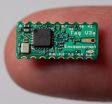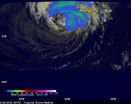(Press-News.org) If two birds meet deep in the forest, does anybody hear? Until now, nobody did, unless an intrepid biologist was hiding underneath a bush and watching their behavior, or the birds happened to meet near a research monitoring station. But an electronic tag designed at the University of Washington can for the first time see when birds meet in the wild.
A new study led by a biologist at Scotland's University of St. Andrews used the UW tags to see whether crows might learn to use tools from one another. The findings, published last week in Current Biology, supported the theory by showing an unexpected amount of social mobility, with the crows often spending time near birds outside their immediate family.
The study looked at crows in New Caledonia, an archipelago of islands in the South Pacific. The crows are famous for using different tools to extract prey from deadwood and vegetation. Biologists wondered whether the birds might learn by watching each other.
The results, as reported by St. Andrews, revealed "a surprising number of contacts" between non-related crows. During one week, the technology recorded more than 28,000 interactions among 34 crows. While core family units of New Caledonian crows contain only three members, the study found all the birds were connected to the larger social network.
The new paper is the first published study using the UW tags to record animal social interactions.
"This is a new type of animal-tracking technology," said co-author Brian Otis, a UW associate professor of electrical engineering whose lab developed the tags. "Ecology is just one of the many fields that will be transformed with miniaturized, low-power wireless sensors."
Biologists normally tag animals with radio transmitters that broadcast at a particular frequency, and field researchers use a receiver to listen for that frequency and detect when the animal is present. An encounter between small animals would only be recorded if the researcher was nearby.
The UW system, called Encounternet, uses programmable digital tags that can send and receive pulses.
"Encounternet tags can monitor each other, so you can use them to study interactions among animals," said co-author John Burt, a UW affiliate professor of electrical engineering. "You can't even start to do that with other radio-tracking technology."
Other research groups are using the UW tags around the world. Researchers at the University of Windsor in Canada are using them to study mating behavior in Costa Rican long-tailed manikins; a researcher at Drexel University is using them to study the interaction between birds and army ants in Costa Rica; German researchers are putting the tags on sea lions in the Galapagos Islands to study their behavior as they pull up on beaches; and researchers in the Netherlands are studying the social behavior of great tits, a small woodland bird.
"It's a big topic right now, the idea that animals have social networks," Burt said. He has been working with field biologists for the last three years to deploy the tags.
"There are other tags that can do proximity logging, but they're all very big and for larger animals. None is as small as Encounternet – or even near to it."
The smallest of the UW tags weighs less than 1 gram (0.035 ounces) and can be used on animals as light as 20 grams (less than an ounce), about the weight of a sparrow. Researchers attach the tags to birds with straps that degrade and harmlessly fall off after the battery dies. The tag records nearby pulses, and the signal strength gives an estimate of the other animal's distance.
A typical study using the system includes a few dozen tags and between 10 and 100 fixed base stations. When tagged animals pass a base station the data is transmitted wirelessly from the tag to the base station, and from there to the Internet. Researchers can also reprogram the tags remotely – for example, they can look at initial results to see when there are few encounters happening, and turn the battery off during those times to conserve power.
Burt completed his doctorate at the UW in 2000, with a dissertation on birdsong communication and learning. He wished that there was a way to automatically monitor bird interactions in the wild, and in 2005 joined forces with Otis, an expert in small, lightweight, low-power electronics. Burt managed the project to develop the tags, with funding from the National Science Foundation, as a research scientist in Otis' group.
This fall they founded Encounternet LLC in Portland, Ore., where Burt now lives. He is working to add a GPS component to record the location of encounters, and to add an accelerometer and other sensors that could detect an animal's behavior.
"People are excited about this because for the first time, it allows them to study smaller animal interactions and social networks on an incredibly fine scale," Burt said. "Social networks are turning out to be key to understanding many animal behaviors. People say Encounternet is the only thing they can find that can collect that information."
INFORMATION:
For more information, contact Otis at botis@uw.edu or 206-427-5061 and Burt at quill65@gmail.com or 206-214-8849. Otis is on leave in California this year and best reached via e-mail.
St. Andrews news release on the Current Biology study: http://www.st-andrews.ac.uk/news/archive/2012/Title,91404,en.html
The original Twitter? Tiny electronic tags monitor birds' social networks
2012-09-21
ELSE PRESS RELEASES FROM THIS DATE:
Moving targets
2012-09-21
PASADENA, Calif.—At any given moment, millions of cells are on the move in the human body, typically on their way to aid in immune response, make repairs, or provide some other benefit to the structures around them. When the migration process goes wrong, however, the results can include tumor formation and metastatic cancer. Little has been known about how cell migration actually works, but now, with the help of some tiny worms, researchers at the California Institute of Technology (Caltech) have gained new insight into this highly complex task.
The team's findings are ...
Modeling Good Research Practices' guidelines for modeling in health care research available now
2012-09-21
Los Angeles, CA (September 20, 2012) SAGE and The Society for Medical Decision Making are pleased to announce the release of seven new reports that will have a significant impact on modeling techniques in health care research and medical decision making. Written by the Modeling Good Research Practices Task Force, a special group of leading experts in decision analysis, economics, simulation, and health policy, these reports were published in a special issue of Medical Decision Making (MDM), a SAGE journal.
"The history of decision and economic modeling to support health ...
Double assault on tough types of leukemias
2012-09-21
Investigators at Northwestern University Feinberg School of Medicine have identified two promising therapies to treat patients with acute megakaryocytic leukemia (AMKL), a rare form of leukemia where the number of cases is expected to increase with the aging population.
The disease is characterized by an overload of white blood cells that remain forever young because they can't mature into specialized cells. Published in a recent issue of the journal Cell, the study found that the drug with the generic name alisertib (MLN8237), induced division and growth of healthy ...
Global economic pressures trickle down to local landscape change, altering disease risk
2012-09-21
The pressures of global trade may heighten disease incidence by dictating changes in land use. A boom in disease-carrying ticks and chiggers has followed the abandonment of rice cultivation in Taiwanese paddies, say ecologist Chi-Chien Kuo and colleagues, demonstrating the potential for global commodities pricing to drive the spread of infections. Their work appears in the September issue of ESA's journal Ecological Applications.
After Taiwan joined the World Trade Organization in 2001, active cultivation of rice paddies fell from 80 percent to 55 percent in just three ...
NASA satellites and Global Hawk see Nadine display more tropical characteristics
2012-09-21
Scientists and forecasters have been analyzing Tropical Storm Nadine using various NASA satellites as NASA's Global Hawk flew over the storm gathering information. Both the Global Hawk and NASA's TRMM satellite noticed that Nadine has continued to display tropical characteristics, indicating that it has not transitioned to an extra-tropical storm.
Forecasters noted that Nadine could have started transitioning into an extra-tropical storm, because there was little significant rainfall near Nadine's center of circulation yesterday, Sept. 19. However, satellite data and ...
New uses for old tools could boost biodiesel output
2012-09-21
Tried-and-true techniques could help optimize oilseed yield for biodiesel production, according to studies conducted by U.S. Department of Agriculture (USDA) scientists.
For more than 30 years, near infrared (NIR) reflectance spectroscopy has been used as a rapid and nondestructive method for measuring protein, moisture, and oil levels in whole grains. Now Agricultural Research Service (ARS) research leader Dan Long is studying how to use remote sensing tools to quickly assess seed oil quality and quantity before and after harvest.
ARS is USDA's chief intramural scientific ...
NASA's solar fleet peers into coronal cavities
2012-09-21
The sun's atmosphere dances. Giant columns of solar material – made of gas so hot that many of the electrons have been scorched off the atoms, turning it into a form of magnetized matter we call plasma – leap off the sun's surface, jumping and twisting. Sometimes these prominences of solar material, shoot off, escaping completely into space, other times they fall back down under their own weight.
The prominences are sometimes also the inner structure of a larger formation, appearing from the side almost as the filament inside a large light bulb. The bright structure around ...
'Half-match' bone marrow transplants wipe out sickle cell disease in selected patients
2012-09-21
In a preliminary clinical trial, investigators at Johns Hopkins have shown that even partially-matched bone marrow transplants can eliminate sickle cell disease in some patients, ridding them of painful and debilitating symptoms, and the need for a lifetime of pain medications and blood transfusions. The researchers say the use of such marrow could potentially help make bone marrow transplants accessible to a majority of sickle cell patients who need them.
After a median follow-up of two years, the transplants successfully eliminated sickle cell disease in 11 of 17 patients. ...
How bumblebees find efficient routes without a GPS
2012-09-21
Scientists from Queen Mary, University of London have tracked bumblebees for the first time to see how they select the optimal route to collect nectar from multiple flowers and return to their nest.
In a paper published in PLOS Biology today (18 September), the scientists, working with the Harmonic Radar Group at Rothamsted Research, were able to use radar tracking to show how bumblebees discover flowers, learn their location and use trial and error to find the most efficient route between flowers over large distances.
Professor Lars Chittka and Dr Mathieu Lihoreau ...
Light squeezed on a quantum scale
2012-09-21
An international team of physicists has pushed the boundaries on ultra-precise measurement by harnessing quantum light waves in a new way.
It is one thing to be able to measure spectacularly small distances using "squeezed" light, but it is now possible to do this even while the target is moving around.
An Australian-Japanese research collaboration made the breakthrough in an experiment conducted at the University of Tokyo, the results of which have been published in an article, "Quantum-enhanced optical phase tracking" in the prestigious journal, Science.
Leader ...



